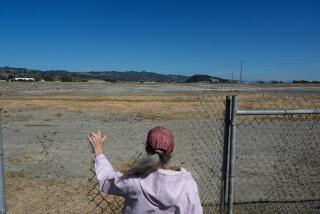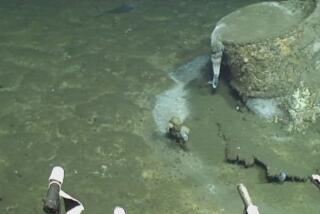Scientists Hunt for H-Bomb Fallout
- Share via
AMCHITKA ISLAND, Alaska — From a distance it looked like laundry day on the Bering Sea coast: a line of kneeling figures in rain gear, scrubbing fuzzy green socks.
But they weren’t washing socks on this remote island. These were scientists collecting moss, algae and muck that will be tested for radiation.
Researchers from federal and state agencies spent three weeks on Amchitka this month, looking for evidence that radioactive material is leaking from the blast cavities formed by three underground nuclear explosions in the 1960s and ‘70s.
Greenpeace researchers came here last summer and said samples they collected had traces of americium 241, a radioactive element produced by nuclear explosions.
The radiation levels weren’t significant, and Department of Energy scientists who examined the samples concluded the radiation came from worldwide atmospheric fallout, not underground leaks.
To settle the question, Greenpeace scientist Norman Buske is overseeing new sample gathering by DOE and the Environmental Protection Agency.
Buske concedes that even if they find radiation, it won’t be in amounts likely to create a health hazard on this uninhabited volcanic rock, 1,350 miles southwest of Anchorage and about 500 miles east of Russia. Test results aren’t expected until the end of September at the earliest.
It isn’t the science that’s remarkable about this expedition, members say. It’s that DOE and Greenpeace are cooperating on a project whose conclusions are going to make one of them look bad.
And the last Amchitka test was the one that led Greenpeace onto the world environmental stage.
The Atomic Energy Commission, the Nuclear Regulatory Commission’s predecessor, set off explosions deep beneath the tundra-covered surface of Amchitka in 1965, 1969 and 1971.
The last test, code-named Cannikin, was a five-megaton blast, the equivalent of about 5 million tons of dynamite and the largest underground blast the nation has ever set off.
It was set off at a depth of more than 5,800 feet, and Greenpeace believes that wasn’t deep enough to prevent leaks.
The 1971 Cannikin test prompted protests from environmentalists, scientists and the Canadian and Japanese governments. Critics said it was needless and threatened to kill marine life and to trigger destructive earthquakes and tidal waves.
Among the noisiest protesters was the Don’t Make a Wave Committee from Vancouver, British Columbia. Its boat, named Greenpeace Two, never reached Amchitka, but the protest marked Greenpeace’s founding.
James Schlesinger, then AEC chairman, brought his wife and two daughters to Amchitka for the Cannikin blast, saying he wanted to underscore the test’s safety. Witnesses stood 23 miles from ground zero.
When the bomb went off, then-9-year-old Emily Schlesinger said, the ground shook “like riding a train.”
Afterward, rock collapsing into the blast cavity created a depression that filled with water and became a small lake, which drains down White Alice Creek into the Bering Sea. Greenpeace argues that the subsidence allowed water to seep into the blast cavity and then carry out radioactive elements.
Amchitka is a bony finger, 43 miles long and just 5 miles at its widest point. But for a kink in the International Date Line to accommodate Alaska, Amchitka and a few other Aleutian Islands would be in tomorrow while the rest of the nation deals with today.
Eagles, otters, sea birds and rats have the place to themselves most of the time. Canada geese are making a comeback since the U.S. Fish and Wildlife Service wiped out the foxes introduced by Russian fur hunters.
Alaska state officials are concerned that toxins from the nuclear tests will enter the food chain that Aleut natives still rely on.
The state’s representative on Amchitka, Doug Dasher of the Department of Environmental Conservation, doubts the new samples will prove conclusively that radiation is reaching the surface.
More likely, Dasher says, some radioactive elements may eventually migrate into the Bering Sea through cracks in the flanks of the island deep underwater. He hopes the Energy Department can pay for research on that issue.
Both Buske and Frank Maxwell, one of the Energy Department scientists, concede that the other side could be right about radioactive leaks.
“Our role is to get answers and do remediation if it’s needed. We don’t start with baggage and preconceptions,” Maxwell said while driving a pickup down the island’s only road.
Buske, sitting in the back seat, responded: “Greenpeace always arrives with baggage and preconceptions. We admit it.”
Buske also said the most important question isn’t whether radiation is threatening the environment, but whether the government lied when it swore the test would be safe, then failed to detect any radioactive leakage.
“It’s the credibility that’s really important,” he said. “That’s what we see as the issue here.”
More to Read
Sign up for Essential California
The most important California stories and recommendations in your inbox every morning.
You may occasionally receive promotional content from the Los Angeles Times.










